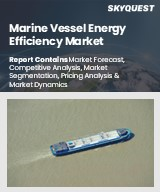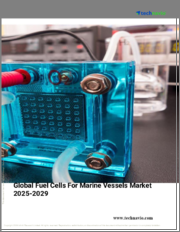
|
시장보고서
상품코드
1801988
선박 에너지 효율화 시장 규모, 점유율, 성장 분석 : 유형별, 용도별, 지역별 - 산업별 예측(2025-2032년)Marine Vessel Energy Efficiency Market Size, Share, and Growth Analysis, By Type (Hardware Systems, Software & Sensors), By Application (Passenger Ships & Ferries, Dry Cargo), By Region - Industry Forecast 2025-2032 |
||||||
선박 에너지 효율화 시장 규모는 2023년에 8억 3,070만 달러로 평가되며, 2024년 8억 5,064만 달러에서 2032년에는 10억 2,836만 달러로 성장하며, 예측 기간(2025-2032년)의 CAGR은 2.4%로 성장할 전망입니다.
선박 에너지 효율화 시장은 규제, 경제, 기술 요인의 결합으로 큰 폭의 성장이 예상됩니다. 엄격한 해양 안전 규제와 연료비 상승으로 선주들은 에너지 효율이 높은 시스템과 대체 연료로 눈을 돌리고 있습니다. 기후 변화에 대한 인식은 하이브리드 추진 시스템, 첨단 선체 설계 등 친환경 기술의 채택을 촉진하고, 정부의 장려책과 업계의 협력도 촉진하고 있습니다. 그러나 첨단 기술의 높은 초기 비용, 숙련된 인력 부족, 대체 연료에 대한 인프라 미비, 구식 선박과의 호환성 문제 등이 큰 걸림돌로 작용하고 있습니다. 이러한 장벽은 획일적인 시장 확대를 방해하고 각 지역의 전반적인 매출 성장에 영향을 미칠 수 있습니다.
목차
서론
- 조사의 목적
- 조사 범위
- 정의
조사 방법
- 정보 조달
- 2차와 1차 데이터 방법
- 시장 규모 예측
- 시장의 전제조건과 제한
개요
- 세계 시장 전망
- 공급과 수요 동향 분석
- 부문별 기회 분석
시장 역학과 전망
- 시장 개요
- 시장 규모
- 시장 역학
- 촉진요인과 기회
- 억제요인과 과제
- Porter의 산업 분석
주요 시장 인사이트
- 주요 성공 요인
- 경쟁의 정도
- 주요 투자 기회
- 시장 에코시스템
- 시장의 매력 지수(2024년)
- PESTEL 분석
- 거시경제 지표
- 밸류체인 분석
- 가격 분석
- 사례 연구
선박 에너지 효율화 시장 규모 : 유형별 & CAGR(2025-2032년)
- 시장 개요
- 하드웨어 시스템
- 소프트웨어와 센서
선박 에너지 효율화 시장 규모 : 용도별 & CAGR(2025-2032년)
- 시장 개요
- 여객선과 페리
- 건화물
- 서비스선
- 어선
- 요트
- 기타 선박
선박 에너지 효율화 시장 규모 & CAGR(2025-2032년)
- 북미
- 미국
- 캐나다
- 유럽
- 독일
- 스페인
- 프랑스
- 영국
- 이탈리아
- 기타 유럽
- 아시아태평양
- 중국
- 인도
- 일본
- 한국
- 기타 아시아태평양
- 라틴아메리카
- 브라질
- 기타 라틴아메리카
- 중동 및 아프리카
- GCC 국가
- 남아프리카공화국
- 기타 중동 및 아프리카
경쟁 정보
- 상위 5사의 비교
- 주요 기업의 시장 포지셔닝(2024년)
- 주요 시장 기업이 채택한 전략
- 최근 시장 동향
- 기업의 시장 점유율 분석(2024년)
- 주요 기업의 기업 개요
- 기업의 상세
- 제품 포트폴리오 분석
- 기업의 부문별 점유율 분석
- 매출의 전년대비 비교(2022-2024년)
주요 기업 개요
- Becker Marine Systems
- Bureau Varitas SA
- GE Vernova
- HHI Engine and Machinery Division
- Kawasaki Heavy Industries
- Kongsberg Gruppen ASA
- Lloyd Register Group Limited
- MAN Energy Solution
- Norsepower Oy
- PoweCell Sweden
- Schneider Electric SE
- Topsoe
- Wartsila Corporation
결론과 제안
KSA 25.09.09Global Marine Vessel Energy Efficiency Market size was valued at USD 830.7 million in 2023 and is poised to grow from USD 850.64 million in 2024 to USD 1028.36 million by 2032, growing at a CAGR of 2.4% during the forecast period (2025-2032).
The marine vessel energy efficiency market is poised for substantial growth driven by a confluence of regulatory, economic, and technological factors. Strict marine safety regulations and escalating fuel expenses are pushing ship owners toward energy-efficient systems and alternative fuels, while growing demands for sustainable shipping amplify this shift. Awareness of climate change is fostering the adoption of eco-friendly technologies, such as hybrid propulsion systems and advanced hull designs, bolstered by government incentives and industry collaborations. However, challenges such as high initial costs for advanced technologies, a lack of skilled workforce, inadequate infrastructure for alternative fuels, and compatibility concerns with older vessels present significant obstacles. These barriers hinder uniform market expansion and may impact overall revenue growth across different regions.
Top-down and bottom-up approaches were used to estimate and validate the size of the Global Marine Vessel Energy Efficiency market and to estimate the size of various other dependent submarkets. The research methodology used to estimate the market size includes the following details: The key players in the market were identified through secondary research, and their market shares in the respective regions were determined through primary and secondary research. This entire procedure includes the study of the annual and financial reports of the top market players and extensive interviews for key insights from industry leaders such as CEOs, VPs, directors, and marketing executives. All percentage shares split, and breakdowns were determined using secondary sources and verified through Primary sources. All possible parameters that affect the markets covered in this research study have been accounted for, viewed in extensive detail, verified through primary research, and analyzed to get the final quantitative and qualitative data.
Global Marine Vessel Energy Efficiency Market Segments Analysis
Global Marine Vessel Energy Efficiency Market is segmented by Type, Application and region. Based on Type, the market is segmented into Hardware Systems and Software & Sensors. Based on Application, the market is segmented into Passenger Ships & Ferries, Dry Cargo, Service Vessels, Fishing Vessels, Yachts and Other Vessels. Based on region, the market is segmented into North America, Europe, Asia Pacific, Latin America and Middle East & Africa.
Driver of the Global Marine Vessel Energy Efficiency Market
The Global Marine Vessel Energy Efficiency market is primarily driven by the implementation of increasingly stringent emissions regulations mandated by governing bodies like the International Maritime Organization (IMO), compelling shipowners to either enhance their vessels or invest in retrofitting solutions. These regulations necessitate that ships operate with greater energy efficiency, as evidenced by the incorporation of measures such as the Energy Efficiency Existing Ship Index (EEXI) and the Carbon Intensity Indicator (CII). Consequently, this environment fosters the adoption of energy-saving technologies, including advanced propulsion systems, optimized hull designs, and waste heat recovery systems, as critical strategies for compliance and enhanced operational efficiency.
Restraints in the Global Marine Vessel Energy Efficiency Market
The Global Marine Vessel Energy Efficiency market faces challenges due to the high initial investment required for acquiring or retrofitting energy-efficient technologies, including hybrid engines and large battery systems, along with advanced fuel-management software. The integration of these solutions can be complex, necessitating comprehensive training for crew members to effectively operate the new systems. While these enhancements promise long-term financial benefits, the substantial upfront costs represent a considerable obstacle, particularly for small and medium-sized operators in emerging markets. This financial burden may deter investment in necessary upgrades aimed at improving energy efficiency in marine vessels.
Market Trends of the Global Marine Vessel Energy Efficiency Market
The Global Marine Vessel Energy Efficiency market is witnessing a robust trend driven by significant advancements in green marine technologies. Innovations such as battery-electric propulsion, wind-assisted propulsion systems, waste heat recovery, and AI-driven energy optimization are revolutionizing shipping practices. These technologies enhance vessel performance by minimizing toxic emissions and reducing fuel consumption, aligning with the growing regulatory focus on sustainability and environmental responsibility in maritime operations. As shipowners increasingly adopt these solutions to comply with stringent maritime policies and meet consumer demand for greener shipping practices, the market is poised for continued expansion and transformation toward energy-efficient maritime solutions.
Table of Contents
Introduction
- Objectives of the Study
- Scope of the Report
- Definitions
Research Methodology
- Information Procurement
- Secondary & Primary Data Methods
- Market Size Estimation
- Market Assumptions & Limitations
Executive Summary
- Global Market Outlook
- Supply & Demand Trend Analysis
- Segmental Opportunity Analysis
Market Dynamics & Outlook
- Market Overview
- Market Size
- Market Dynamics
- Drivers & Opportunities
- Restraints & Challenges
- Porters Analysis
- Competitive rivalry
- Threat of substitute
- Bargaining power of buyers
- Threat of new entrants
- Bargaining power of suppliers
Key Market Insights
- Key Success Factors
- Degree of Competition
- Top Investment Pockets
- Market Ecosystem
- Market Attractiveness Index, 2024
- PESTEL Analysis
- Macro-Economic Indicators
- Value Chain Analysis
- Pricing Analysis
- Case Studies
Global Marine Vessel Energy Efficiency Market Size by Type & CAGR (2025-2032)
- Market Overview
- Hardware Systems
- Software & Sensors
Global Marine Vessel Energy Efficiency Market Size by Application & CAGR (2025-2032)
- Market Overview
- Passenger Ships & Ferries
- Dry Cargo
- Service Vessels
- Fishing Vessels
- Yachts
- Other Vessels
Global Marine Vessel Energy Efficiency Market Size & CAGR (2025-2032)
- North America (Type, Application)
- US
- Canada
- Europe (Type, Application)
- Germany
- Spain
- France
- UK
- Italy
- Rest of Europe
- Asia Pacific (Type, Application)
- China
- India
- Japan
- South Korea
- Rest of Asia-Pacific
- Latin America (Type, Application)
- Brazil
- Rest of Latin America
- Middle East & Africa (Type, Application)
- GCC Countries
- South Africa
- Rest of Middle East & Africa
Competitive Intelligence
- Top 5 Player Comparison
- Market Positioning of Key Players, 2024
- Strategies Adopted by Key Market Players
- Recent Developments in the Market
- Company Market Share Analysis, 2024
- Company Profiles of All Key Players
- Company Details
- Product Portfolio Analysis
- Company's Segmental Share Analysis
- Revenue Y-O-Y Comparison (2022-2024)
Key Company Profiles
- Becker Marine Systems
- Company Overview
- Business Segment Overview
- Financial Updates
- Key Developments
- Bureau Varitas SA
- Company Overview
- Business Segment Overview
- Financial Updates
- Key Developments
- GE Vernova
- Company Overview
- Business Segment Overview
- Financial Updates
- Key Developments
- HHI Engine and Machinery Division
- Company Overview
- Business Segment Overview
- Financial Updates
- Key Developments
- Kawasaki Heavy Industries
- Company Overview
- Business Segment Overview
- Financial Updates
- Key Developments
- Kongsberg Gruppen ASA
- Company Overview
- Business Segment Overview
- Financial Updates
- Key Developments
- Lloyd Register Group Limited
- Company Overview
- Business Segment Overview
- Financial Updates
- Key Developments
- MAN Energy Solution
- Company Overview
- Business Segment Overview
- Financial Updates
- Key Developments
- Norsepower Oy
- Company Overview
- Business Segment Overview
- Financial Updates
- Key Developments
- PoweCell Sweden
- Company Overview
- Business Segment Overview
- Financial Updates
- Key Developments
- Schneider Electric SE
- Company Overview
- Business Segment Overview
- Financial Updates
- Key Developments
- Topsoe
- Company Overview
- Business Segment Overview
- Financial Updates
- Key Developments
- Wartsila Corporation
- Company Overview
- Business Segment Overview
- Financial Updates
- Key Developments



















